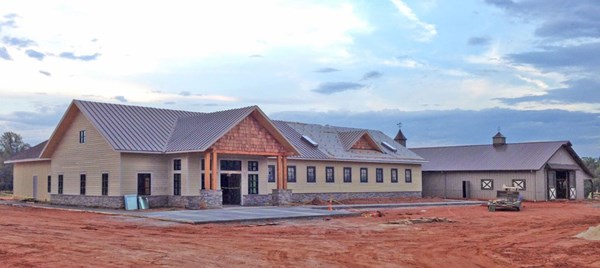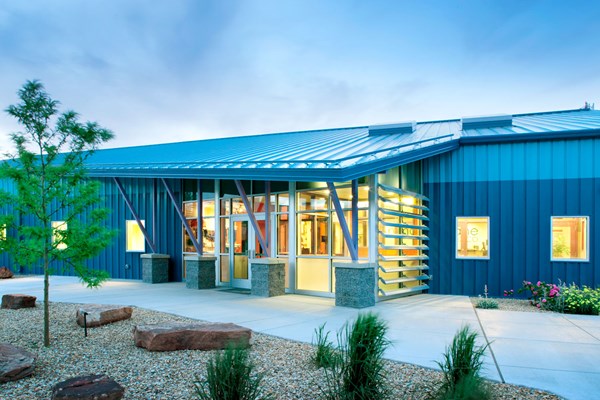According to the tale of the three little pigs, bricks end up keeping the pigs safe from the big bad wolf. In reality, construction is not that easy. The choice of materials and methods involves many factors, including costs, labor markets, material availability, durability, aesthetics and energy performance. Veterinarians seeking to build equine hospitals can be overwhelmed by the choices. In this article, we’ll explore the best construction methods for these facilities.
 Credit: Animal Arts Tryon Equine Hospital
Credit: Animal Arts Tryon Equine HospitalPrefabricated Structures
The most common question we receive from veterinary practices is whether to build a building from scratch or to order a prefabricated building and fit it out. In order to understand how to make this decision, let’s review the most common types of prefabricated structures: pole barns and metal buildings.
Pole Barns
Pole barns are constructed of large, evenly spaced wood posts that are sunk into the ground to create a building frame. In between the building frame, smaller wood members and metal panels are placed to create the building skin.
You are probably familiar with pole barn structures if you can imagine the inside of a typical hay building or farm shed. Pole buildings can be dressed up. and covered with nicer materials on the outside. Morton Buildings is one example of a pole barn builder. If you browse their website, you see that it can provide a variety of buildings, from low-cost farm buildings to more expensive buildings such as offices and hospitals.
There are some reasons why a pole building might not be the best long-term solution for an equine hospital. Over time, the wood posts can rot. A pole barn might not be adequate in extreme climates or in regions with heavy snow loads. For example, it is not typical to see pole barns in Hawaii as the wet, rocky soil would be inadequate to support the wood posts. Pole buildings might also be a poor choice in certain seismic areas where earthquakes are common, as they lack some lateral stability.
Most building codes and permitting agencies distinguish between agricultural buildings and commercial buildings. Commercial buildings would include equine veterinary hospitals, and you have to comply with stricter codes than for agricultural buildings such as barns. Many veterinary practices realize that a barn can be more simply and economically constructed than a hospital. So it is not unusual to mix pole barns with a traditionally built hospital.
Metal Buildings
 Credit: Animal Arts Humane center in New Mexico
Credit: Animal Arts Humane center in New MexicoFor a step up in durability, some of our clients purchase a prefabricated metal building. It is not unusual for a veterinary practice to fit out a previously constructed metal building. You are probably familiar with metal buildings, as many arenas and larger agricultural structures are built using this method. A metal building has a large steel rigid frame, regularly spaced. This frame is covered with smaller girts and purlins, then sheathed with a metal skin. The frame is more durable than a wood post frame because of the material used and because each steel column is bolted to a concrete foundation, leaving the structure above the surface of the ground.
The metal frame can provide additional rigidity to wind and seismic “live” loads. However, collapses of metal buildings occasionally make the news, as the roof purlins and metal roof skins are sometimes inadequately engineered to resist the forces of heavy snow “dead” loads. Nevertheless, a properly designed metal building can be used anywhere, and it is an economical structure.
While many people use metal buildings, they present some significant shortcomings that are important to understand and overcome. These include:
Aesthetics. They tend to be unattractive, with an overly simplified shape and low-sloped roof. It’s hard to look at a metal building and forget that it is a metal building, even when it is dressed up on the exterior.
Energy performance. An equine hospital is a commercial building, which means that it must comply with today’s energy codes. These codes might require you to provide “continuous insulation,” which means that insulation cannot be placed between purlins and girts, as is the traditional method for insulating a metal building. The manufacturers of metal buildings have responded by creating a new method of insulation that is placed on the outside of the building frame, but this increases the costs.
Interior durability. The inside of a metal building is nothing more than exposed insulation and metal girts. For a hospital space, it is necessary to build a wall to the inside of the metal skin, out of metal stud or even concrete block, to ensure that you will get a durable finish on the inside. This is why metal buildings become less economical when they surround complicated interior spaces.
Supporting mechanical units. Metal buildings are best used for lightly ventilated applications, such as arenas. It is difficult to support large mechanical units from the underside of the steel structure, and for highly ventilated structures such as hospitals, the mechanical units often get parked outside the building, where they make noise and take up space.
Despite the above shortcomings, the allure of metal buildings is still significant. If a client of ours has to stick to a tight budget or a tight timeframe, this is what we do to ensure they have the choice to use a metal building if it makes sense for their project: We design the hospital to be a rectangle or a simple ‘L’ shape. That way, the veterinary practice can explore the economics of a metal building versus traditional construction without having to adapt their plans.
If we are using a metal building, we incorporate these concepts to improve the end product:
• We use a steeper roof pitch for im proved aesthetics.
• We ask for eaves and overhangs, which are not always included in a metal building. Eaves and overhangs make a building look more like a traditional structure.
• We specify the proper insulation to comply with building energy codes.
• We use custom windows rather than the windows that come with the metal building. For example, aluminum storefront openings can make a metal building perform better.
• We use a colorful exterior to make the building appear more cheerful.
• We specify a fluoropolymer finish rather than a silicone polyester finish on the exterior panels. Silicone polyester coatings fade and get powdery over time, which you can probably recall from your memories of inexpensive ag buildings.
Traditionally Built Structures
 Credit: Animal Arts A wood truss roof is shown here.
Credit: Animal Arts A wood truss roof is shown here.For larger equine hospitals with medical and surgical spaces, high ventilation needs and the desire for better aesthetics or a custom configuration, it is best to construct a traditional building. Below are the most commonly used materials:
Concrete block masonry. This can provide both the exterior structural wall and the interior durable finish. In some climates such as in Florida, it can be locked together with poured concrete to provide hurricane resistance. Concrete block is not as common on the West Coast due to the types of lateral forces that earthquakes create.
Wood construction. Wood wall studs are less common today, but wood roof trusses are common and economical for building pitched roofs. Single-story hospitals often have concrete block and/or metal stud walls and wood truss roofs.
Metal stud walls. Metal studs are lightweight, consistent and inexpensive in most areas of the country. They work well for creating light commercial spaces, and they can be used for the human-occupied areas of the hospital, including reception, pharmacy and office. We don’t recommend them in equine areas due to their lightweight nature. Metal studs are usually combined with steel columns and beams to support heavy roof loads.
A traditionally built building can be any size or shape, and it can be completely customized to your needs. A traditionally built hospital may cost somewhere between $225-$300 per square foot or more in California and other expensive regions. Using a metal building may save 10-15%, and a pole barn slightly more, but the savings is not dramatic because the skin of a building represents a small portion of the total cost of building a hospital.
Take-Home Message
It is a great idea to consider different construction methods with the help of your contractor and design professional. Strive to understand the pros and cons of each method. Prefabricated buildings are adequate outbuildings, and they can save dollars for hospital construction when dollars really count. But there is still a grain of truth in the tale of the three little pigs: It is wise to invest in a durable building so it will keep you safe and comfortable for many years to come.








